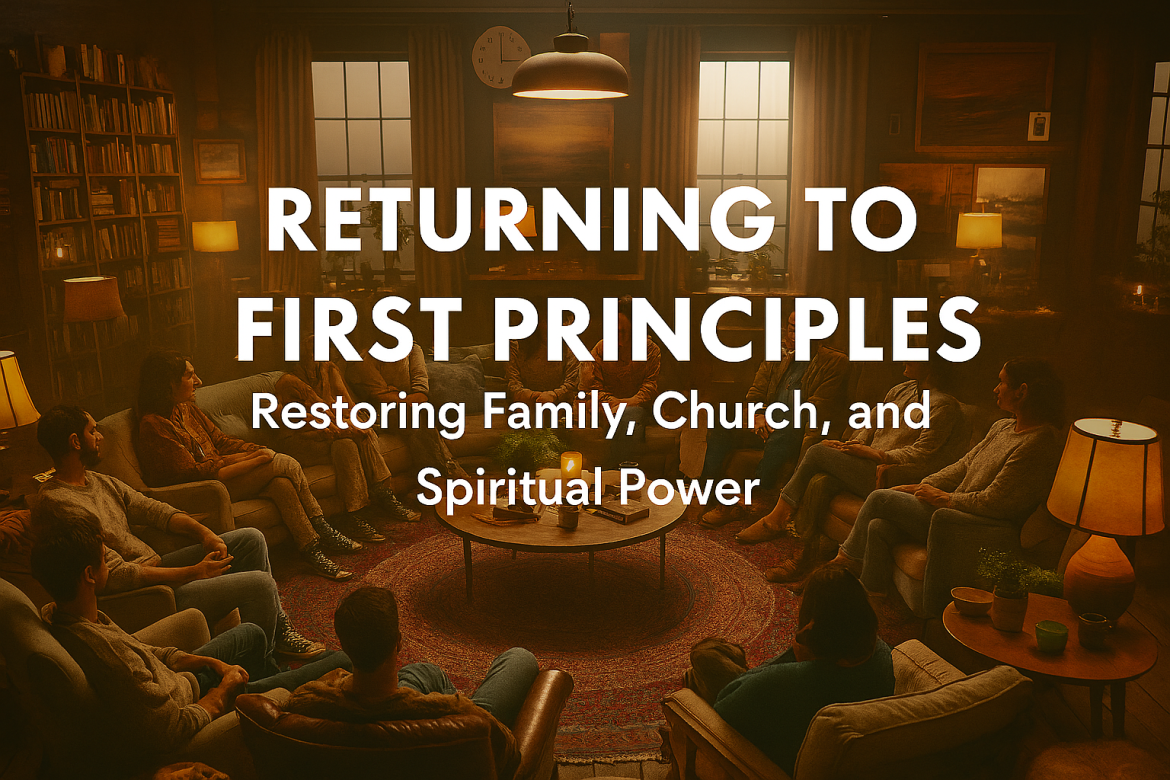Five Things We Will Learn
- Why returning to God’s first principles—rather than man’s innovations—is key to restoring both family and church.
- How Elon Musk’s “first principles thinking” aligns with biblical wisdom, and why the Church should pay attention.
- What the New Testament Church looked like in its original, house-to-house format, and why it was so powerful.
- What elements of modern church culture can be removed without violating the biblical definition of the Church.
- How a restored, Spirit-filled Church model produces reverence, repentance, unity, miracles, and true discipleship.
The Breakdown We Can No Longer Ignore
We are living in a generation where the biblical model of family has nearly vanished. Scripture paints a beautiful, ordered picture of family: husbands loving and leading like Christ (Ephesians 5:25), wives nurturing and partnering in strength (Proverbs 31), children honoring parents and being raised in the discipline and instruction of the Lord (Ephesians 6:1–4).
But today’s families are fractured. Now, individuals within natural families increasingly turn to institutions—both physical and digital—that attempt to substitute for God’s original intent. This shift is made tragically obvious as families sit together but remain glued to the opinions of others on social media and immersed in digital relationships with byproducts of “artificial intelligence.” Despite this hyperconnectivity, studies show that people are growing more lonely, anxious, depressed, and suicidal. The U.S. Surgeon General recently declared loneliness an epidemic, identifying it as a “public health crisis” with effects equivalent to smoking 15 cigarettes a day and significantly increasing the risk of premature death (Source: U.S. Surgeon General’s Advisory on the Healing Effects of Social Connection and Community, 2023).
This isn’t limited to natural families. The Church has likewise drifted. Instead of anchoring itself in the first principles laid out for us in the history book of the Church—the Bible—it has largely abandoned its biblical blueprint. Scripture shows us exactly how the Church lived, met, and functioned as a new spiritual family in Christ. But just as natural families have traded the authentic for the artificial, many churches have traded the presence of God for larger buildings, more polished programs, big screens, skinny jeans, and smoke machines.
And we must ask: Is this trade-off worth forfeiting the very presence of God’s Spirit among us? We should also ask: Is what we are currently doing as the Church truly working?
Comparing Today’s Church to First Principles
When we compare how today’s church gathers and functions to the first principles laid out in Scripture—when the Church first met—we must ask ourselves:
According to God’s design, what can be taken away and it still be “the Church” as spoken of in Scripture?
What elements are truly essential, and what have we added that might be cluttering or even replacing the original power and purity of what God intended?
Related:
- Dynamics of Shepherds and Sheep, Finding Safety in our Good Shepherd’s Care
- Is It Time to Rethink Church?
- Explosive Church Growth in Cuba; Following Simple Biblical Truth
- Prophesy- Revival Coming to Cuba
- Suffering in Cuba Has Produced Massive Church Growth with no signs of Slowing Down
- Family: God’s Original Intent for the Church – It’s like the Church of Acts: dreams, visions, miracles, healings
- House Church or CHURCH that meets in the House: A Big Difference!
- Back to Basics for the Church
The Power of Returning to the Foundation
Elon Musk, in solving some of the world’s most complex problems, has popularized the engineering mindset known as first-principles thinking. He explains:
“I think it’s important to reason from first principles rather than by analogy… Boil things down to the most fundamental truths and reason up from there.”
— Elon Musk
In another insight from his management philosophy, Musk says that you should:
“Delete any part of the process you can. If you do not end up adding back at least 10% of them, then you didn’t delete enough.”
He’s not a spiritual guide—but his success in simplifying complex systems illustrates a powerful truth: real solutions are found when we return to the original design.
This is not new wisdom. It’s biblical.
“This is what the Lord says: ‘Stand at the crossroads and look; ask for the ancient paths, ask where the good way is, and walk in it, and you will find rest for your souls.’”
— Jeremiah 6:16 (NIV)
“If the foundations are destroyed, what can the righteous do?”
— Psalm 11:3 (ESV)
God has always called His people back to first principles—His ancient, unshakable ways—not toward innovation, but restoration. In a world obsessed with reinvention, God’s wisdom is in rediscovery.
What Happens When the Church Forgets the Foundation
It’s not just the family that’s broken. The Church mirrors the same decay:
- Fatherless homes inside the church
- Divorce statistics nearly identical to the world
- A lack of reverence, accountability, and spiritual power
Much like a family, the church was originally designed as a spiritual household. The early believers didn’t gather in megastructures but in homes. Leadership was personal, discipleship was relational, and the fear of the Lord was tangible.
Related:
- Rethinking Church- Not Us and Them, Just US
- Church is an Organism, not an Organization
- Re -Thinking Church- Vision for the Outside
- Re –Thinking Church Revisited
- Re-Thinking Church – Stats say it isn’t Working
- Re-thinking Church
- Re-Thinking Church- Institutionalized, Confined, and Contented?
- Rethinking Church: We made it Up, George Barna
Back to the Church of the Bible
The New Testament is, quite literally, a collection of letters written from houses to houses.
The apostles weren’t writing to congregations gathered in cathedrals or auditoriums. They were writing to believers gathered in homes—ordinary people meeting from house to house (Acts 2:46; Acts 20:20). These letters were passed from one household to another, read aloud among spiritual families, and taken seriously as the living Word of God.
Paul greets the church that meets in the house of Priscilla and Aquila (Romans 16:5). In 1 Corinthians 16:19, he sends greetings from another house church. Colossians 4:15 mentions the church that meets in Nympha’s house. This was not occasional—it was the norm.
They didn’t merely “attend church.” They were the Church, gathering in living rooms, breaking bread at dinner tables, praying together, discipling one another, and devoting themselves to the apostles’ teachings (Acts 2:42).
And the fruit? Deep unity, repentance, shared resources, the fear of the Lord, miracles, and God adding to their number daily.
If we want to return to a New Testament church, we must return to the New Testament pattern: disciples gathering in homes, devoting themselves to Jesus, to one another, and to the Spirit-inspired letters we now know as Scripture.
When God Is Present, Everything Changes
In Acts 5, Ananias and Sapphira lied to the Holy Spirit and fell dead. It wasn’t because of a lack of generosity—but a breach of spiritual integrity. The result?
“Great fear seized the whole church and all who heard about these events… Nevertheless, more and more men and women believed in the Lord and were added to their number.”
— Acts 5:11, 14 (NIV)
The Spirit of God was present. And where the Spirit is truly present, so is order, reverence, repentance, and power.
When we strip away the cultural layers we’ve added to church, we rediscover:
- Holiness and integrity — sin was confronted (Acts 5:1–11)
- Reverence and awe — a renewed fear of the Lord (Acts 2:43; 5:11)
- Gospel growth — God added to their number (Acts 2:47; 5:14)
- Signs and wonders — the sick were healed, demons cast out (Acts 5:15–16)
- Daily discipleship — homes became hubs of worship, prayer, and teaching (Acts 2:46–47)
Returning to God’s First Principles
We must rediscover:
- God’s design for marriage and parenting (Genesis 2:24; Deuteronomy 6:6–9; Ephesians 5–6)
- The home as a center of worship and community (Acts 2:42–47; Romans 16:5)
- Accountability and repentance as the pathway to revival (Acts 5:1–11; James 5:16)
- The fear of the Lord as the beginning of wisdom (Proverbs 9:10)
- The presence of the Holy Spirit as essential for power and growth (Acts 4:31; 5:12–16)
Elon Musk’s use of first-principles thinking is a reminder—when we return to the essentials, we return to what works. But we have something more than effectiveness—we have truth revealed by God. His Word is our blueprint, His Spirit our power, His Son our cornerstone.
Related:
- Re-Thinking Church: God is a God of order but his name is not Robert
- Vine Seminar: Original Intent of the Church
- The Church is Good but Religion has to GO
- Acts 2:42 Vision: The Church of Acts and the Combine Harvest! “I saw Jesus face to face.” Chris Reed
- Five Keys to Spreading the Gospel: Insights from Steve Addison’s “Movements That Change the World
A Tale of Two Churches: Then and Now
The Church at Its Founding
In the book of Acts and the New Testament epistles, the early Church was:
- Relational, not institutional — they met in homes (Acts 2:46; Romans 16:5)
- Led by spiritual fathers, not corporate hierarchies (1 Timothy 3:1–7; Titus 1:5)
- Unified in doctrine and lifestyle, not fragmented by denominations (Acts 2:42; Ephesians 4:3–6)
- Empowered by the Holy Spirit, not run by human strategy (Acts 4:31; 1 Corinthians 12)
- Focused on discipleship, not attendance (Matthew 28:19–20; Acts 14:21–23)
- Marked by holiness and repentance, not entertainment (Acts 5:1–11; 1 Corinthians 5)
- Gospel-centered, not personality-driven (1 Corinthians 2:1–5)
- Sacrificial and generous, not consumeristic (Acts 2:44–45; 2 Corinthians 9:7)
The Church Today (in many places)
The modern Western Church often looks like this:
- Program-heavy, with minimal real relationships
- Facility-focused, with high budgets and mortgage burdens
- Celebrity-driven, centered on charisma over character
- Performance-based, with worship resembling concerts
- Fragmented, with thousands of denominations and doctrinal divisions
- Discipleship-light, emphasizing decisions over transformation
- Entertainment-oriented, seeking to attract more than equip
- Passive participation, where many attend but few are engaged
- Tech-dependent, increasingly disconnected from actual human presence
- Silently compromising, with little confrontation of sin or cultural idolatry
“See to it that no one takes you captive through hollow and deceptive philosophy, which depends on human tradition and the elemental spiritual forces of this world rather than on Christ.”
— Colossians 2:8 (NIV)
What Can Be Taken Away?
In light of the biblical model, if we are to return to first principles—what the Church is at its core—we must ask: What can be taken away and it still be “the Church” as spoken of in Scripture?
Below are elements we can remove without compromising the essence of Christ’s Church:
✘ What Can Be Taken Away
(Without violating the biblical definition of Church)
- Church Buildings
- Nowhere commanded or modeled as essential
- The early Church met in homes (Romans 16:5; Acts 20:20)
- Professional Clergy Class
- All believers are priests (1 Peter 2:9)
- Leadership was elder-based, relational, and raised up from within (Titus 1:5)
- Stage Performances and Concert-Style Worship
- Worship was Spirit-led and participatory (1 Corinthians 14:26)
- God seeks worship in spirit and truth (John 4:23–24)
- Programs, Branding, and Church Marketing
- The early Church grew by the power of the Spirit and word of mouth (Acts 2:47; Acts 5:14)
- No apostles had logos or social media campaigns
- Sermon-Centric Model
- Teaching was important—but so was discussion, mutual edification, and doing (Acts 2:42; James 1:22)
- “One-man show” preaching isn’t the New Testament (NT) norm
- Denominational Labels
- The NT Church was united in Christ, not divided by brand (1 Corinthians 1:10–13; Ephesians 4:4–6)
- Membership Rolls and Institutional Titles
- The Lord added to their number (Acts 2:47)
- They were known by fruit, not formal affiliation (Matthew 7:16–20)
- Financial Overhead & Church Debt
- Offerings went to the poor and to support traveling ministers (Acts 4:34–35; 2 Corinthians 8–9)
- No NT church went into debt to build structures
What Can’t Be Taken Away?
To remain the Church as Jesus and the apostles defined it, we must keep:
- Jesus as the Head (Colossians 1:18)
- The Word of God as the foundation (Acts 2:42; 2 Timothy 3:16)
- The Holy Spirit as the empowering Presence (Acts 1:8; Romans 8:14)
- The fellowship of the saints (Hebrews 10:24–25)
- Prayer, worship, and communion (Acts 2:42–47)
- Repentance, holiness, and obedience (1 Peter 1:15–16; Acts 3:19)
- Discipleship and multiplication (2 Timothy 2:2; Matthew 28:19)
- Sacrificial love and unity (John 13:34–35; Ephesians 4:1–3)
The more we subtract, the more clearly we see what cannot be removed. What’s left is the Church.
“Stand at the crossroads and look; ask for the ancient paths…” (Jeremiah 6:16)
The Church that Jesus birthed and the Spirit empowered is not lost—it’s just buried beneath layers we’ve added.
It’s time to return.
Related:
- “The Church is Not Structural but Organic” Charles Simpson
- Why I Choose to Believe the Bible: A Reflection on Faith and Reason, Voddie Baucham, Greg Lancaster
- CHURCH: What is it and What is it’s Purpose? God’s Original Intent?
- Family: God’s Original Intent for the Church
- Family: God’s Original Intent for the Church – It’s like the Church of Acts: dreams, visions, miracles, healings
Don’t Redesign. Rediscover.
Our homes don’t need reinvention—they need restoration. Our churches don’t need upgrades—they need revival. And that begins not with new strategies, but with ancient truths.
“Unless the Lord builds the house, the builders labor in vain.”
— Psalm 127:1 (NIV)
Revival is not found in the next big movement. It’s found in going back—back to God’s Word, back to His Spirit, back to the family He designed, and the Church He birthed.
Scripture References
Jeremiah 6:16
Psalm 11:3
Acts 2:42–47
Acts 5:1–16
Acts 20:20
Romans 16:5
1 Corinthians 16:19
Colossians 4:15
Ephesians 5:22–33; 6:1–4
Deuteronomy 6:6–9
Genesis 2:24
Proverbs 9:10
Psalm 127:1




